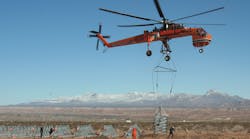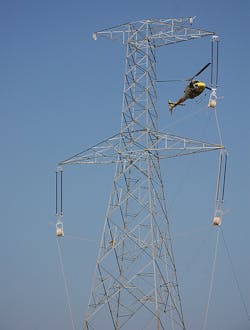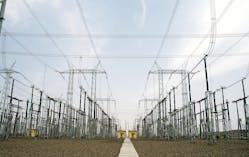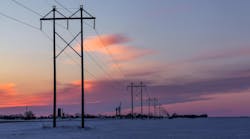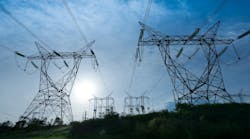India’s increase in installed generation capacity produced 8.4% more output in 2015. This increase, coupled with an augmented transmission system, has reduced the country’s energy shortfall from a range of 7% to 11%, down to 3.6%. However, the majority of India’s 1.3 billion population still has no access to a reliable electricity supply. Reducing the shortfall is a mammoth task for this vast and populous nation, so despite the increase in generating capacity, India is still ranked low in terms of an annual energy consumption rate of 1000 kWh per capita. This compares with annual consumption rates of 2500 kWh per capita in Brazil, 3000 kWh per capita in China and 6500 kWh per capita in Russia.
Currently, the Indian government’s policy is to provide an uninterrupted supply of electrical energy to all, a goal that is likely to increase the energy consumption per capita. In common with many countries, India’s generation resources are unevenly dispersed and, in general, remote from load centers. More importantly, the development of the country’s transmission system has lagged the growth in demand. This has resulted in low plant load factors (around 60%) because of congestion and a lack of transmission system capacity, which prevents distribution utilities from procuring the energy required to supply customer demands.
Hence, the focus is now on the T&D sectors, evident from the 32% increase in the rate of transmission line commissioning from 16,748 circuit km (10,407 miles) in 2013-2014 to 22,101 circuit km (13,734 miles) in 2014-2015. Similarly, during 2014-2015, the installed system transformer capacity increased by 65,554 MVA, some 1375 MVA higher than the target set for the year. This increase in transmission infrastructure investment reflects the appetite for additional capacity following the Indian government’s 2009 decision to allow private investment.
It is not easy to commission critical transmission projects. In India, acquiring land and securing rights-of-way (ROW) for transmission projects is difficult because farmers’ rights must be protected, and they must be compensated for their losses. It is getting equally difficult to negotiate new corridors in metropolitan areas and densely populated cities. The use of several cutting-edge technologies not previously used in India has been necessary to overcome these challenges.
Kashmir Valley
The cold Kashmir Valley in the western Himalayas suffered from frequent load shedding, especially during winters when the electricity demand increased sharply and generation from the existing hydro plants dipped. Additionally, transmission constraints restricted the supply of electricity to the valley from outside the states of Jammu and Kashmir, leaving massive power cuts as the only option.
In mid-2014, Sterlite Power Grid Ventures Ltd. was awarded the Northern Region System Strengthening (NRSS) 29 project to facilitate the importation of 2000 MW into the states of Jammu and Kashmir from the neighboring state of Punjab. With a capacity of 2000 MW, this project will provide the growth engine for increasing power requirements in states that have suffered for decades because of extreme weather and terrorism.
This major transmission project involves the construction and commissioning of a 900-km (559-mile) overhead transmission line and 400-kV gas-insulated substation in Amargarh, located in northern Kashmir. When complete, the transmission line — connecting Jalandhar in Punjab to Amargarh through the challenging Kashmir Valley — will traverse dense forests as well as snow-clad and avalanche-prone Himalayan ranges to provide Jammu and Kashmir with an alternate link to the national grid.
Helicopter Crane
Normally, this type of overhead line construction work would be undertaken by mules and porters to haul components piece by piece to the jobsite. This time-consuming, labor-intensive process tests the patience of logistics managers because each step depends on weather and health conditions of the technical staff and porters.
The time frame for the NRSS 29 project was 50 months. To achieve this target, Sterlite Grid selected Erickson Inc. to construct and install the transmission towers at an altitude of between 9000 ft and 12,500 ft (2743 m and 3810 km) in the rough terrain of the Pir Panjal range. This involved the use of Erickson’s S-64 Aircrane, a heavy-lift helicopter. This was the first private power transmission line development that deployed a helicopter in construction.
The utility has invested some Rs 30 billion (US$465 million) to fulfill this contract for the government of India. With the use of helicopter-aided construction techniques, and given the significance of this project, the aim is to complete construction of this critical asset 10 months ahead of schedule.
Helicopter Stringing
The 765-kV Bhopal-Dhule Transmission Co. Ltd. (BDTCL) project has presented many construction challenges. The first was land acquisition, and the second was the development of the land purchased to make it suitable for construction of a 765-kV substation. This project included extending the 765-kV transmission system 1000 circuit km (621 miles) in length and constructing two 1500-MVA, 765/400-kV substations in Bhopal and Dhule.
To minimize any potential delays, helicopter-stringing technology was used to overcome difficulties related to securing ROW. Helicopter stringing enables the quick execution of conductor installation, which can be a tedious and time-consuming process. Moreover, it reduces site time, enabling shorter transmission line shutdowns.
This technology also is in use with the construction of the 765-kV and 400-kV transmission lines for the BDTCL project in central India. The process creates minimal disturbance to the local community and the environment, which, in turn, avoids complexities related to ROW intrusions.
Substation Innovation
The construction of the 765-kV Dhule substation demanded superior technical capabilities and exceptional project management skills to meet the target completion date. The site for the substation was in a commercially significant area, and it was difficult to secure an area of 46.8 hectares (115.5 acres). Finally, when the land was available, there were serious issues with its suitability. The land was undulating and rocky, with slopes in two directions; hence, it was too costly to consider complete site leveling. To overcome this problem, the undulated land was divided in slopes and steps, an innovation that enabled work on the project to start without delay after the land acquisition.
As the Dhule substation is a critical element in India’s western region, its reliability had to be guaranteed at any cost. Therefore, the design specification included the installation of switchable spare reactors and transformers. This ensures the substation is capable of clearing faults within 30 minutes, without any mechanical intervention, thereby increasing system reliability and maximizing availability.
The efficient delivery of the Dhule substation was backed by a strong supply chain. The supply of material and equipment was tracked daily to supplement planned erection activities. The site construction team ensured erection and other construction work were not hampered by material shortage.
The Dhule substation showcased the introduction of innovative new technologies. Collaborations were established with some of the world’s best manufacturers and contractors such as Alstom, Hyundai Electric and Baoding Tianwei Baobian Electric for the engineering, procurement and construction of the substation; supply of seven 500-MVA, 765/400-kV transformers; and supply of eleven 80-MVAR, 765-kV reactors. To ensure safe operational conditions, a nitrogen firefighting system was installed in the substation for the first time at a 765-kV level in India. The quality of execution is evident by the fact the substation has consistently delivered 100% availability since its commissioning.
Both 765-kV substations were commissioned in 17 months, compared with the scheduled contract period of 36 months. Because of this achievement, the project won recognition from the Ministry of Power for delivering a critical link in the western grid in record time.
LiDAR Effectiveness
Advanced aerial light detection and ranging (LiDAR) technology for surveys was first used for transmission line optimization on the Bhopal-Dhule overhead line project and the Jabalpur Transmission Co. Ltd. project. This overhead line survey was undertaken in addition to a detailed manual survey for two overhead lines. Combined with PLS-CADD, the LiDAR survey enabled transmission line engineers to evaluate several alignment options, including the cost of construction, and helped the engineers to identify an alternative solution that was both cost effective and expeditious.
Rajasthan Project
The Rajasthan transmission project consisted of erecting a 400-kV double-circuit transmission line over a 200-km (124-mile) route through the states of Rajasthan and Madhya. This circuit acts as an interregional link to strengthen the transmission systems associated with the Rajasthan nuclear power plant, which enables power exchanges between the northern and western grids. This transmission project was commissioned in less than 12 months, ahead of the scheduled completion date, and directly benefits the states of Madhya, Pradesh, Punjab and Haryana.
Unmanned Aerial Vehicles
Sterlite Grid’s operation and maintenance team strive to maintain the reliability of the overhead line transmission system at 99%. To help achieve this, the latest technology being made available to the team is the introduction of unmanned aerial vehicles. The utility recently signed a joint-venture agreement with Sharper Shape for this service, which also will be made available to other transmission line project developers.
Sterlite Grid designs, finances, constructs and maintains transmission projects. Within a short time period, the utility has earned many firsts in Indian’s transmission system sector:
• The first transmission utility to deploy conductor stringing and aerial technologies for surveys (LiDAR)
• The first private utility to be awarded 765-kV double-circuit transmission lines on a build, own, operate and maintain (BOOM) basis in the country
• The first private enterprise to be recognized and honored by the Ministry of Power for the early commissioning of the two 1500-MVA, 765/400-kV substations included in the 765-kV BDTCL project
• The first Indian utility to attract private foreign investment in the transmission sector
• The first to commission a competitively awarded Rajasthan atomic power project transmission project ahead of schedule.
Achievements
As a result of combining cutting-edge technologies with intelligent project management systems, Sterlite Grid has demonstrated it is possible to complete major projects ahead of schedule. The performance in these challenging projects is encouraging in a country where the shortfall in transmission system capacity is restricting load growth and depriving large sectors of the population access to a supply of electrical energy.
Acknowledgement
The author wishes to acknowledge the support and assistance of Jaspreet Kaur of Sterlite Power Grid Ventures Ltd. in the preparation of this article. ♦
Mitul Thakkar heads corporate communications for Sterlite Power Grid Ventures Ltd., supporting also the business development section, which provides him with the opportunity to write on energy, infrastructure and economy. Before joining Sterlite Power Grid Ventures Ltd., he spent a decade as a journalist with India’s business news dailies, the Economic Times and Business Standard.
